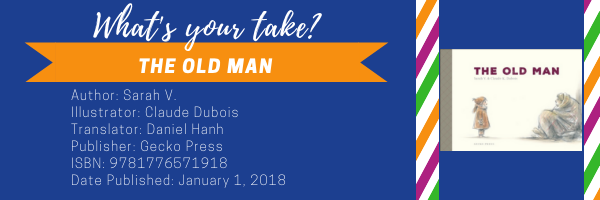By Janelle B. Mathis, PhD, University of North Texas and Katie Loomis, Librarian and Doctoral Student, University of North Texas
Contemporary literature has examples of the relationships that children develop with adults—parents, grandparents, and people they meet unexpectedly through shared experiences. The books discussed this month each reveal children relating to adults in very authentic ways— sometimes through a relationship and sometimes through their own impulse to act, speak, or ask questions. In thinking about child agency, the books show how the most natural or simplest of connections can resonate in powerful ways with adults.

The Old Man (2018) by Sarah V., illustrated by Claude Dubois. Lerner Publishing Group. 72 pages.
A Story Like the Wind (2018) by Gill Lewis, illustrated by Jo Weaver. Eerdmans Publishing. 80 pages.
A Drop of the Sea (2018) by Ingrid Chabbert, illustrated by Raul Nieto Guridi. Kids Can Press. 36 pages.
The Visitor by Antje Damm. Gecko Press. 32 pages.
The House of Lost and Found by Martin Widmark and Emilia Dziubak. Floris Books. 40 pages.
A simply told and formatted book, The Old Man opens with a child waking up and preparing to go to school. The story then shifts to a homeless man lying outside and waking up as well on a cold, wet morning. The reader follows him throughout the day as he searches for food, warmth, shelter and tries not to be noticed. He goes to a shelter but when asked his name, he can’t remember it and leaves, but he does remember being a postman earlier in life when watching one going by. He is confronted by people ignoring him, police saying he has to move– loneliness. As the day goes on, he bundles within a blanket in the park as the child shown earlier walks by and simply offers him her sandwich. Smiling, she says he looks like a teddy bear. With a smile inside, the old man returns to the shelter and when asked his name he says, “Teddy.”A final page shows a seemingly warm room with a pot of food and people eating together.
Janelle: The illustrations are most impressive and serve to emphasize each aspect of the story, almost impressionistic as character’s features and details of the setting are never quite clear. Created with watercolors in neutral shades with a touch of sepia, the images are centered within each page of this very small book and the white space surrounding each scene draws the reader’s eyes to the visual story. The narrator tells simply the life of this homeless man, a universal situation given the book was written originally in France. What touched me most was the child just noticing the man in a pleasant way – a gesture that interrupted the ongoing loneliness. Offering her sandwich was an authentic agentic act – not one that was formalized, organized, or expecting praise but just a child observing a need and taking part in the community around her. It was a reminder to me that often it is the little acts that can be the seeds of difference and change. For this man, I was left with hope that through this seed of agency, planted by the girl, he could eventually regain his sense of humanity and identity as he joined others at the shelter. From his memories as a postman, it is obvious that he has the ability to get beyond this place in his life. The hazy illustrations make it possible to imagine the story beyond what is told here. It is a reminder to not disregard the potential of a child to see beyond the surface.
Katie: A homeless man who has trouble remembering who he is, Teddy’s story is not unusual for homeless people. What makes this book different is the frankness in which homelessness is presented in the book. It gives the reader a sense of what Teddy goes through to survive, with no place to sleep, to stay warm, no food to eat, or simply relax. We glimpse into his past as he recalls his life as a mailman. We also are presented with a real look at his mental issues when he can’t remember his name at the homeless shelter/soup kitchen. These are all real instances that could easily happen. Throughout the reading of this book, I wondered what happened to Teddy for him to be homeless, what circumstances led to this life. His loneliness and depressed nature are also very real. The story shifts when Teddy is approached by a little girl who offers him her sandwich. This simple act of kindness seemed to reaffirm his sense of being and gave him the courage to go back to the shelter, hopefully find himself again. I found this book to be heartwarming and would definitely share this with children.
Title: The Old Man
Author: Sarah V.
Illustrator: Claudia Navarro
ISBN: 9781776571918
Publisher: Lerner Publishing Group
Pub Date: January 1, 2018
This is the first installment of January’s issue of My Take Your Take. Check back next month to see what books we’ve selected and to follow the conversation!
- Themes: Janelle Mathis, Katie Loomis, Old Man
- Descriptors: My Take/Your Take
